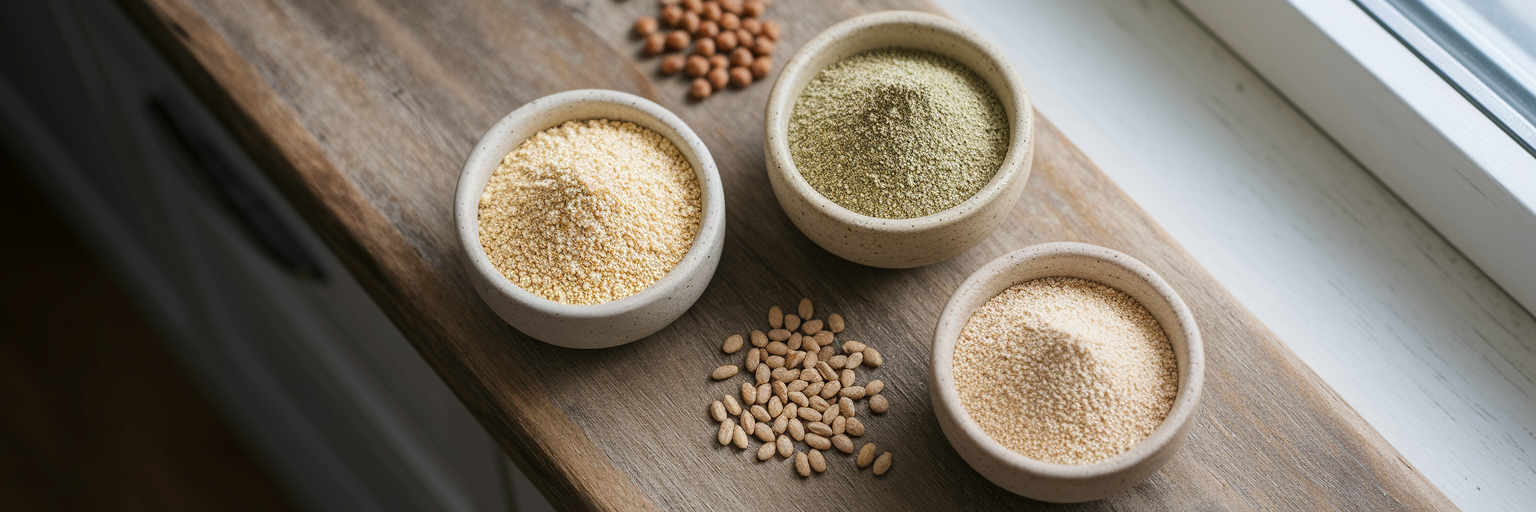Starting Your Plant-Based Protein Journey
Welcome! If you're here, you're probably curious about adding plant-based protein to your routine, and that's a fantastic move for your fitness and well-being. Just a few years ago, finding a good vegan protein powder felt like a treasure hunt. Today, they're a staple in kitchens and gym bags across the U.S., and for good reason.
Plant proteins offer a wonderful way to support your body. They are often packed with fiber and other essential nutrients, and many people find them gentler on the digestive system. It’s not about chasing trends; it’s about finding what makes your body feel its best. Choosing to go plant-based with your protein is a smart, positive step toward your goals.
But let's be honest, the sheer number of options can feel a bit overwhelming. Pea, hemp, rice, blends… what’s the difference? Don't worry. We've put together this simple plant based protein powder guide to turn that confusion into confidence. Think of us as your friendly guide, here to help you find the perfect match for your lifestyle. If you're interested in exploring more wellness topics, you can always find fresh insights on our blog.
Decoding the Different Protein Sources

Once you start looking, you'll notice a few key players in the world of vegan protein powder ingredients. Each one has its own unique strengths, and understanding them is the first step to finding your favorite. Let's break down the most common sources without any confusing jargon.
- Pea Protein: This is one of the most popular options, and for good reason. It’s rich in branched-chain amino acids (BCAAs), which are crucial for muscle repair and growth after a workout. It’s also naturally hypoallergenic, making it a safe bet for those with soy or dairy sensitivities.
- Hemp Protein: Think of hemp as the well-rounded, all-in-one source. It’s a complete protein, meaning it contains all nine essential amino acids your body needs. Plus, it brings healthy omega-3 and omega-6 fats and a good dose of fiber to the table, supporting overall wellness.
- Brown Rice Protein: This one is the gentle giant. It’s known for being incredibly easy to digest, making it perfect for anyone with a sensitive stomach. While its amino acid profile is good, it's a little lower in lysine. That’s why you’ll often see it paired with pea protein to create a more robust, complete profile.
- Protein Blends: This is the "best of all worlds" approach. Smart brands combine multiple plant sources—like pea, rice, and various seeds—to create a powerful, complete amino acid profile. These blends are designed to deliver everything your muscles need, making them a fantastic all-around choice.
Here’s a quick look at how they stack up:
| Protein Source | Key Feature | Best For | Amino Acid Profile |
|---|---|---|---|
| Pea Protein | High in BCAAs (Leucine, Isoleucine, Valine) | Muscle repair and growth | High in most essential amino acids, but lower in methionine |
| Hemp Protein | Complete protein with omegas and fiber | Overall wellness and balanced nutrition | Contains all 9 essential amino acids |
| Brown Rice Protein | Hypoallergenic and easy to digest | Individuals with sensitive stomachs or allergies | Good profile, but lower in lysine; best when blended |
| Protein Blends | Synergistic, complete profile | Maximizing muscle building and all-around use | Formulated to be complete and balanced, mimicking whey |
Aligning Protein Powder with Your Fitness Goals
Now that you know the main types of protein, let's connect them to what you want to achieve. The right powder for someone looking to build muscle might be different from someone focused on general health. It’s all about matching the product to your purpose.
For Muscle Building
If your goal is to build strength and support muscle growth, you’ll want to look for a powder with a higher protein content, typically 20-25 grams per serving. Pay close attention to the BCAA content, especially leucine, which is the primary amino acid responsible for kicking off muscle protein synthesis. A high-quality pea protein or a multi-source blend is often the best vegan protein for muscle gain because they are specifically formulated for performance and recovery.
For Weight Management
When weight management is the focus, protein can be a great tool for helping you feel full and satisfied. Look for a powder with a moderate amount of protein (around 15-20 grams), low sugar, and ideally, some added fiber. This combination helps curb cravings and supports a balanced diet without adding unnecessary calories. A scoop in a morning smoothie can set a positive tone for the rest of your day.
For General Wellness
Maybe you’re not trying to be a bodybuilder or lose weight. You just want to supplement your diet and make sure your body has what it needs for daily recovery. In this case, the focus shifts from high protein content to clean, simple ingredients. A powder with around 15 grams of protein is plenty. As nutrition experts at Healthline point out, protein needs vary based on your goals. For daily wellness, a simple scoop in your oatmeal or a smoothie is perfect. You can find some delicious ideas in our favorite vegan protein recipes.
How to Read the Nutrition Label Like a Pro

Walking down the supplement aisle can be dizzying, but knowing what to look for in protein powder makes it simple. Our guiding principle is this: less is more. A short, recognizable ingredient list is almost always a good sign. It shows the brand isn't trying to hide anything behind fillers or artificial additives.
Here are a few common ingredients to watch out for:
- Maltodextrin: This is a highly processed carbohydrate that can cause unwanted spikes in blood sugar. It's often used as a cheap filler.
- Artificial Sweeteners: Ingredients like aspartame, sucralose, and acesulfame potassium can sometimes cause digestive upset for some people and have a distinct aftertaste.
- Gums and Thickeners: While not always bad, things like xanthan gum or carrageenan can cause bloating and discomfort in sensitive individuals.
One of the most important things to look for is a "Third-Party Tested" seal. Think of this as an independent stamp of approval. It means an outside lab has verified that what's on the label is actually in the tub, ensuring the product is free from contaminants and the protein count is accurate. It’s a simple way to guarantee quality and transparency. When you know what to look for, a clean label stands out, like the one on our chocolate vegan protein.
Considering Flavor, Mixability, and Sustainability
Beyond the nutrition label, a few practical details will determine if a protein powder becomes a staple in your pantry. Let's talk about the experience of actually using it. We’ve all heard the old complaints about plant proteins being gritty or having an earthy taste. The good news is that product technology has come a long way. The best powders today are smooth, creamy, and delicious.
Flavor is personal, so don't be afraid to read reviews or try a sample pack if a brand offers one. A powder that blends easily into water or a smoothie without clumps is a joy to use, while one that doesn't can become a daily frustration. It has to taste good and feel good for you to stick with it.
Finally, consider the company behind the product. Many of us who choose plant-based options also care deeply about the planet. Look for brands that use eco-friendly packaging, like post-consumer recycled materials, and are transparent about where they source their ingredients. Choosing a brand that aligns with your values makes every scoop feel even better. It’s about supporting a company that cares about your health and the planet's health. You can learn more about our mission and commitment to transparency on our site.
Your Simple Checklist for the Perfect Pick
Feeling more confident? Great! We've covered a lot, so here’s a simple checklist you can use the next time you're shopping. It’s the easiest way to remember how to choose vegan protein powder that’s right for you.
- My Goal: Am I focused on muscle building, weight management, or general wellness?
- My Protein Source: Does pea, hemp, brown rice, or a blend sound best for me?
- The Label: Is the ingredient list short and clean, without any weird additives?
- The Proof: Is it third-party tested for purity and quality?
- My Preference: Do I like the flavor, and do the brand's values resonate with me?
With this checklist, you're ready to make a great choice. Ready to find your match? Feel free to explore our collection of clean, plant-based proteins. We hope you find one you love!



